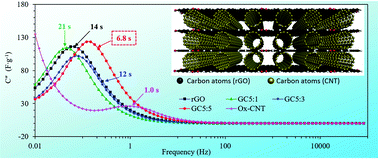Molecular interaction balanced one- and two-dimensional hybrid nanoarchitectures for high-performance supercapacitors†
Abstract
Hybridisation of one-dimensional (1D) and two-dimensional (2D) materials to enhance charge storage has received considerable attention, but a fundamental understanding of the inherent ratio-dependent charge transfer mechanisms associated with the modulation of their molecular interactions is still within the community. Herein, we examined 1D surface oxidised carbon nanotubes (Ox-CNTs) and 2D reduced graphene oxide (rGO) to understand their ratio-dependent charge transfer and molecular interaction dynamics. We found that stepwise ultrasonication and the self-assembly process can control the thermodynamic molecular interactions, which result in rGO and Ox-CNT suspensions not only well dispersed in N,N-dimethylformamide but also self-organised into sandwiched nanoarchitectures. We reveal that the enhanced charge storage performance originated from the Ox-CNT-mediated low contact resistance between the active material and the current collector, and the incorporation of rGO leads to a significant ion diffusion coefficient and gives rise to numerous ion diffusion channels for high rate retention. Through a systematic electrochemical characterisation, we found that the GC5 : 5 hybrids (mass ratio of rGO to Ox-CNT) provide the best compromise-balance ratio between rGO and Ox-CNT for realising a champion energy density (9 W h kg−1) and power density (10 kW kg−1) beyond the state-of-the-art performance of the individual materials. Our results herald the advent of molecular level hybridisation of 1D–2D materials for high-performance electrochemical energy storage.

- This article is part of the themed collection: 2019 PCCP HOT Articles


 Please wait while we load your content...
Please wait while we load your content...